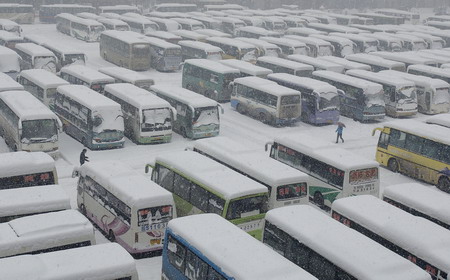Rethink travel plans: Met chief
Updated: 2008-01-31 07:05
The worst snow and ice storms in five decades are likely to continue lashing much of central and southern China for at least three days, prompting the top weatherman to urge travelers to abandon plans for long journeys.
 Zheng Guoguang |
Zheng Guoguang, chief of the China Meteorological Administration (CMA), yesterday said the icy temperatures, snow and sleet, which have struck much of the country's central, eastern and southern regions for two weeks, are likely to continue to disrupt transportation through the Spring Festival, as temperatures show no signs of rising.
The holiday, which begins on Feb 6, is the most important on the Chinese calendar and railway officials had estimated a passenger flow of 178.6 million people - the size of the combined population of Italy, France and Britain. But thousands of travelers have ended up being stranded in crammed stations after electric trains were stalled.
"For the sake of their safety, and relieving the stress on transport, I advise migrant workers to stay in the cities where they work," Zheng told China Daily.
Earlier, the meteorological agency had appealed to residents to avoid unnecessary outdoor activities.
"There is an interval of reduced rainfall and snow forecast for around Saturday, but you can't expect power-cut-hit railways and icebound highways to be restored to normal immediately."
There are reports that traffic flow is improving in central and southern provinces but hundreds of thousands of passengers are still trapped on highways and rail stations.
Zheng explained that the most severe winter weather seen in China for half a century was largely caused by the steady cold fronts from the north reacting with the continuous flow of warm humid currents from the south.
 |
|
Inter-provincial buses are parked at a bus station due to heavy snowfall in Hefei, East China's Anhui Province January 27, 2008. China issued a weather alert as widespread heavy snow that has blanketed parts of the nation is forecast to continue this week. [Agencies] |
"In the past, such a process would last a few days; but this month, they've been lingering there, causing abundant precipitation, and snow and sleet to blanket much of central and southern China," Zheng said.
The CMA has made "pretty accurate" forecasts, and has delivered messages to residents through various means including mobile phones and digital bulletins, Zheng said.
The unusually low temperatures - minus 6 to 0 C for most of the affected regions, which is up to 4 C degrees lower than the average - have exacerbated the situation. For example, power lines have been weighed down by ice and sleet, causing them to snap and pylons to topple.
Yang Guimin, chief CMA forecaster, yesterday also said the prolonged low temperature was not only a result of bad weather, but also an instigator - as long as there is rainfall or snowfall, low temperature would prevent them from evaporating or melting, thus further worsening ground conditions.
"In normal weather conditions, it would take at least one week for full restoration of power supply; against the current backdrop, it will take far longer for electricity supply, and road and railway traffic to return to normal," Zheng said.
Spokesperson Jiao Meiyan blamed the streak of bad weather partly on La Nina, which means "little girl" in Spanish.
La Nina is an oceanographic phenomenon due to colder ocean temperatures and can lead to relatively hotter summers and colder winters.
China is not the only victim of La Nina. North America, Latin America and Europe, as well as some parts of Asia have been hit by snowstorms this winter.
Yu Xinwen, an official from CMA, said the government will launch a five-year project to prevent and pre-warn of meteorological disasters.
|
|
|
||
|
||
|
|
|
|